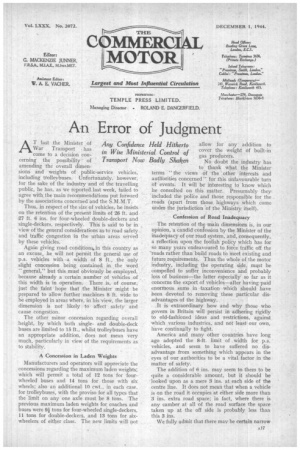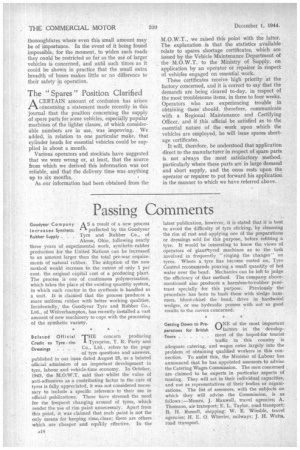An Error of Judgment
Page 19

Page 20

If you've noticed an error in this article please click here to report it so we can fix it.
AT last the Minister of War Transport has come to a decision concerning the possibility of sions and weights of public-service vehicles, including trolleybuses. Unfortunately, however, for the sake of the industry and of the travelling public, he has, as we reported.last week, failed to agree with the main recommendations put forward by the associations concerned and the S.M.M.T.
Thus, in respect of the size of vehicles, he insists on the retention of the present limits of 26 ft. and 27 ft. 6 ins, for four-wheeled double-deckers and single-deckers, respectively. This is said to be in view of the general considerations as to road safety and traffic congestion in the urban areas served by these vehicles.
Again giving road condition in this country as an excuse, he will not permit the general use of p.s. vehicles with -a width of 8 ft., the only slight concession being contained in the word "general," but this must obviously be employed, because already a certain number of vehicles of• this width is in operation. There is, of course, just the faint hope that the Minister might be prepared to allow further machines 8 ft. wide to be employed in areas where, in his view, the larger dimension is not likely to affect safety and cause congestion.
The other minor concession regarding overall height, by which both singleand double-deck buses are limited to 15 ft., whilst frolleybuses have an appropriate addition, does not mean. very much, particularly in view of the requirements as to stability.
A Concession in Laden Weights Manufacturers and operators will appreciate the concessions regarding the maximum laden weights; which will permit a total of 12 tons for fourwheeled buses and 14 tons for those with six wheels; also an additional 10 cwt.. in each case. for trolleybuses, with the proviso for all types that the limit on any one axle must be 8 tons. The previous maximum laden weights for coaches and buses were si tons for four-wheeled single-deckers, 11 tons for double-deckers, and 13 tons for sixwheelers of either class. The new limits will not allow for any addition to cover the weight of built-in gas producers.
No doubt the industry has to thank what the Minister terms "the views Of -the other interests and authorities concerned" for this unfavourable turn of events. It will be interesting to know which he consulted on this matter. Presumably they included the police and those responsible for the roads (apart from those highways which come under the jurisdiction Of the Ministry itself).
Confession of Road Inadequacy The retention of the main dimensions is, in our opinion, a candid confession by the Minister of the inadequacy of our road system, and, consequently, a reflection upon the foolish policy which has for so many years endeavoured to force traffic off the 'roads rather than build roads to meet existing and future requirements. Thus the whole of the motor industry, including the operating side, most be compelled to suffer inconvenience and probably loss of business—the latter especially so far as it concerns the export of vehicles—after having -paid enormous sums in taxation which should have been devoted to removing these particular disadvantages of the highway.
it is extraordinary how and why those who govern in Britain will persist in adhering rigidly to old-fashioned ideas and restrictions, against which various industries, and not leastour own, have continually to fight.
America and many other countries have long ago adopted the 8-ft. limit of width for p.s. vehicles, and seem to have suffered no disadvantage from something which appears in the eyes of our authorities to be a vital factor in the matter of safety.
The addition of 6 ins, may seem to them to be quite a considerable amount, but it should be -looked upon as a mere 3 ins, at each side of the centre line. It does not mean that when a vehicle is on the road it occupies at either side more than 3 ins, extra road space; in fact, where there is any camber at all of the road surface the space taken up at the off side is probably less than this 3 ins.
We fully admit that there may be certain narrow thoroughfares where even this small amount may be of importance. In the event of it being found impossible, for the moment, to widen such roads they could be restricted so far as the use of larger vehicles is concerned, and until such times as it could be shown in practice that the small extra breadth of buses makes little or no difference to their safety in operation.
The "Spares" Position Clarified
A CERTAIN amount of confusion has arisen concerning a statement made recently in this journal that the position concerning the supply of spare parts for some vehicles, especially popular machines of the lighter classes, of which considerable numbers are in use, was improving. We added, in relation to one particular make, that cylinder heads for essential vehicles could be supplied in about a month.
Various operators and stockists have suggested that we were wrong or, at least, that the source from which we derived this information was not reliable, and that the delivery time was anything up to six months, As our information had been obtained from the M.O.W.T., we raised this point with the latter. The explanation is that the statistics available relate to spares shortage certificates, which are issued by the Vehicle Maintenance Department of the M.O.W.T. to the Ministry of Supply, on application by an operator or repairer in respect of vehicles engaged on essential work.
These certificates receive high priority at the factory concerned, and it is correct to say that the demands are being cleared to-day, in respect of the most troublesome items, in three to four weeks. Operators who are experiencing trouble in obtaining these should, therefore, communicate with a Regional Maintenance and Certifying Officer, and if this official be satisfied as to the essential nature of the work upon which the vehicles are employed, he will issue spares shortage certificates.
It will, therefore, be understood that application direct to the manufacturer in respect of spare parts is not always the most satisfactory method, particularly where these parts are in large demand and short supply, and the onus rests upon the operator or repairer to put forward his application in the manner to which we have referred above.




















































